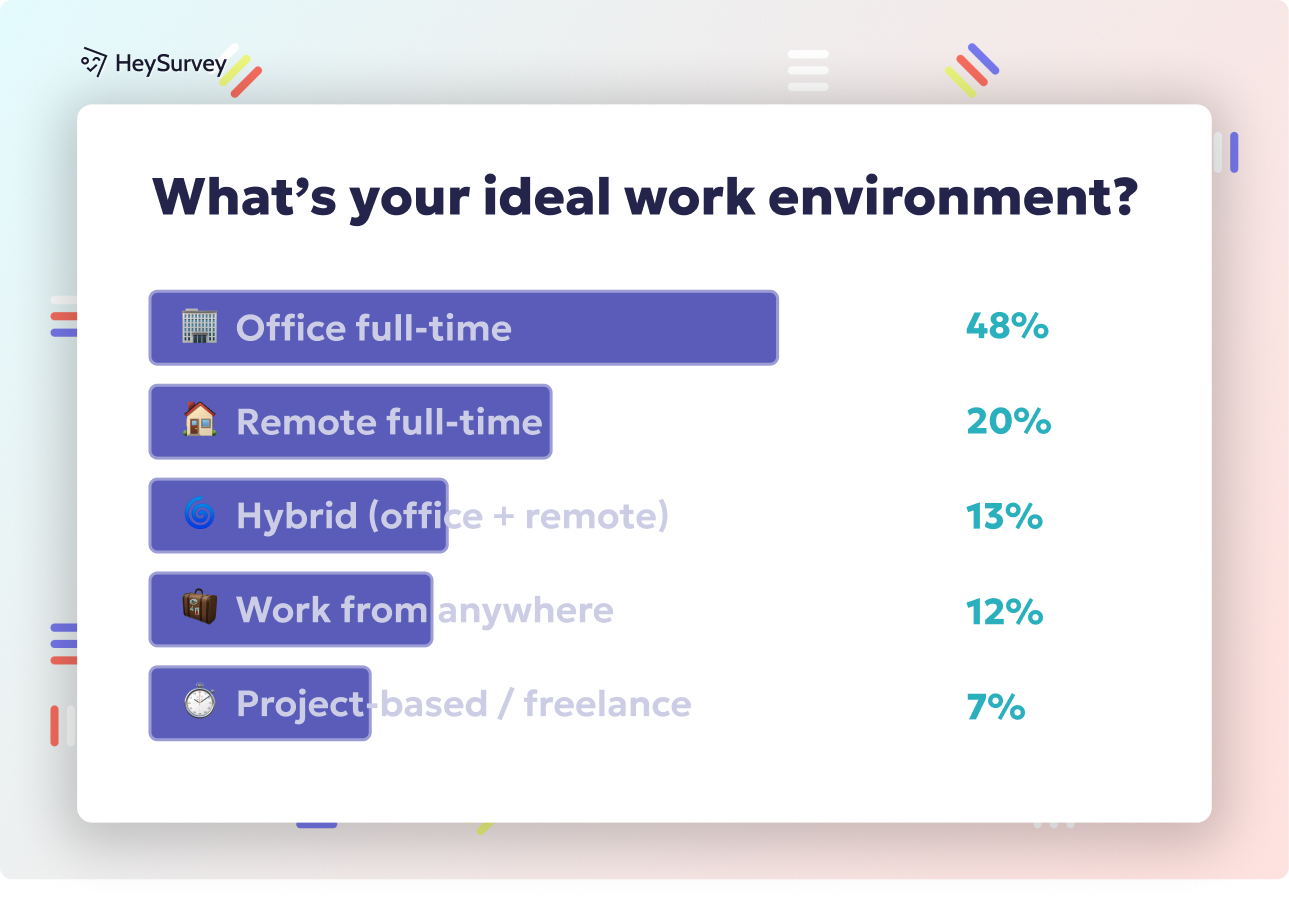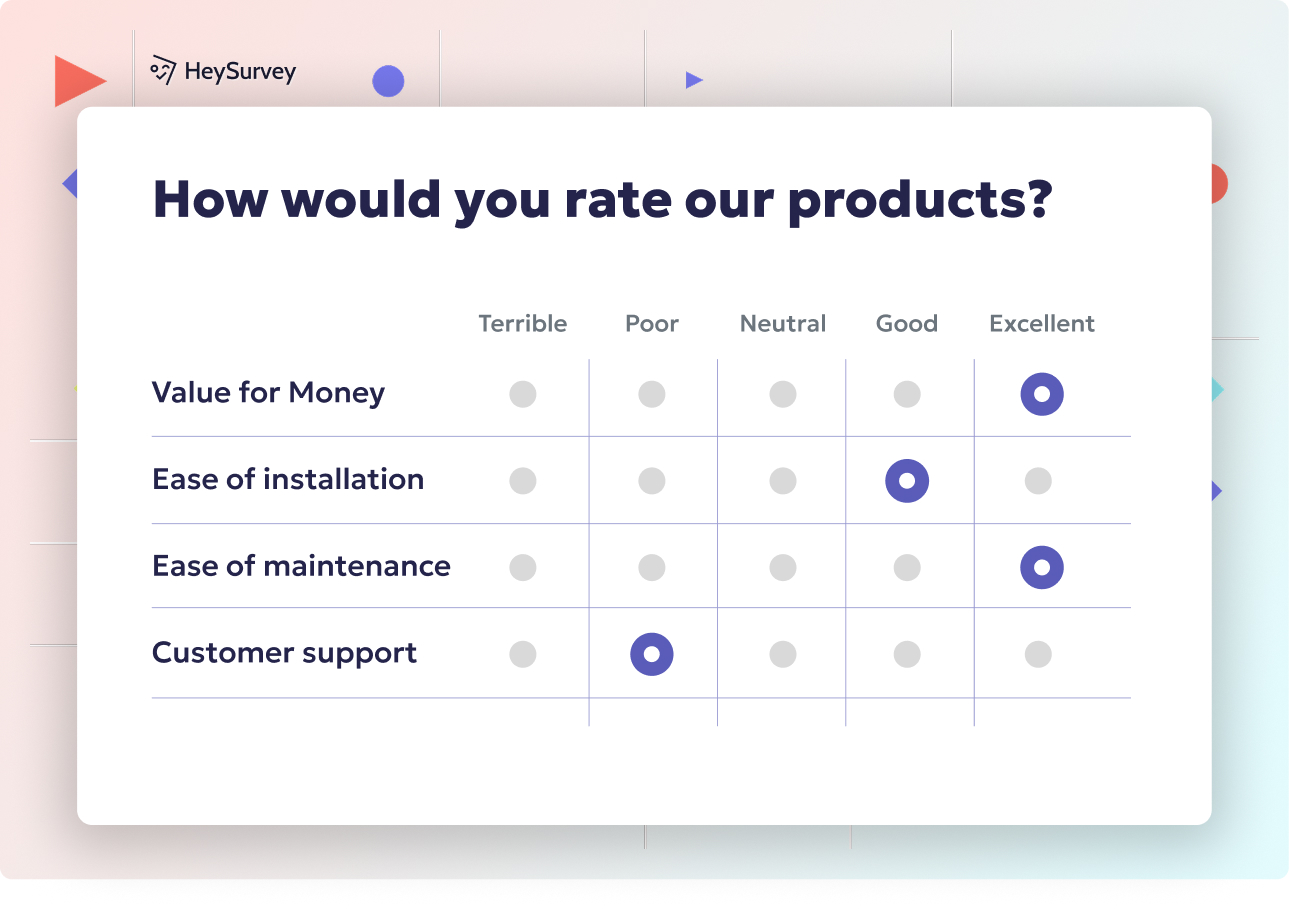28 Ratio Survey Questions Examples for Accurate Data Collection
Discover 25+ ratio survey questions examples with true zero values across industries, boosting precise data for customer spend, productivity, pricing, and more.
Ratio survey questions might sound like something a statistician would whisper about in a secret club, but they’re actually your behind-the-scenes powerhouse for data clarity. Unlike other question types, these collect real numbers with a true zero and equal intervals, making arithmetic magic possible. Whether you’re running a competitive pricing study, mapping customer budgets, or timing employee productivity, knowing when and how to use ratio scale examples can upgrade your surveys from guesswork to goldmine. Let’s uncover how numeric survey questions with true zero are the unsung heroes of quantitative questionnaire design across industries.
What Are Ratio Survey Questions and Why They Matter
Understanding Ratio-Scale Questions
Ratio survey questions ask respondents to provide answers in true numerical terms—think of dollars spent, hours worked, or cups brewed—where zero means absolutely none of that thing happened. The magic here is that these questions enable you to do real arithmetic, like adding, subtracting, multiplying, and dividing answers.
- Equal intervals mean the difference between, say, 5 and 10 dollars is exactly the same as the difference between 15 and 20 dollars.
- The presence of a true zero sets these questions apart from interval questions (like temperature in Celsius, which doesn’t have a true zero).
- Only ratio data allows you to make statements like “twice as much” or “half as many.”
With ratio survey questions, the power of analysis jumps up several notches compared to nominal, ordinal, or interval data:
- You can meaningfully calculate averages (means), coefficients of variation, and ratios—hello, ROI analysis and segmentation!
- You can detect precise differences and shifts, not just ranked or rated changes.
Researchers, UX teams, HR professionals, and marketers choose ratio wording whenever:
- They need numbers they can feed directly into financial models, forecasts, or usage analytics.
- Granular, quantifiable improvement or impact is central to campaign, product, or policy design.
Put simply, if you want your data to speak with real-world numbers and absolute certainty, ratio scale examples should be your go-to.
Ratio scale questions, characterized by a true zero point and equal intervals, enable precise quantitative analysis, allowing for meaningful arithmetic operations and statistical computations. (zonkafeedback.com)
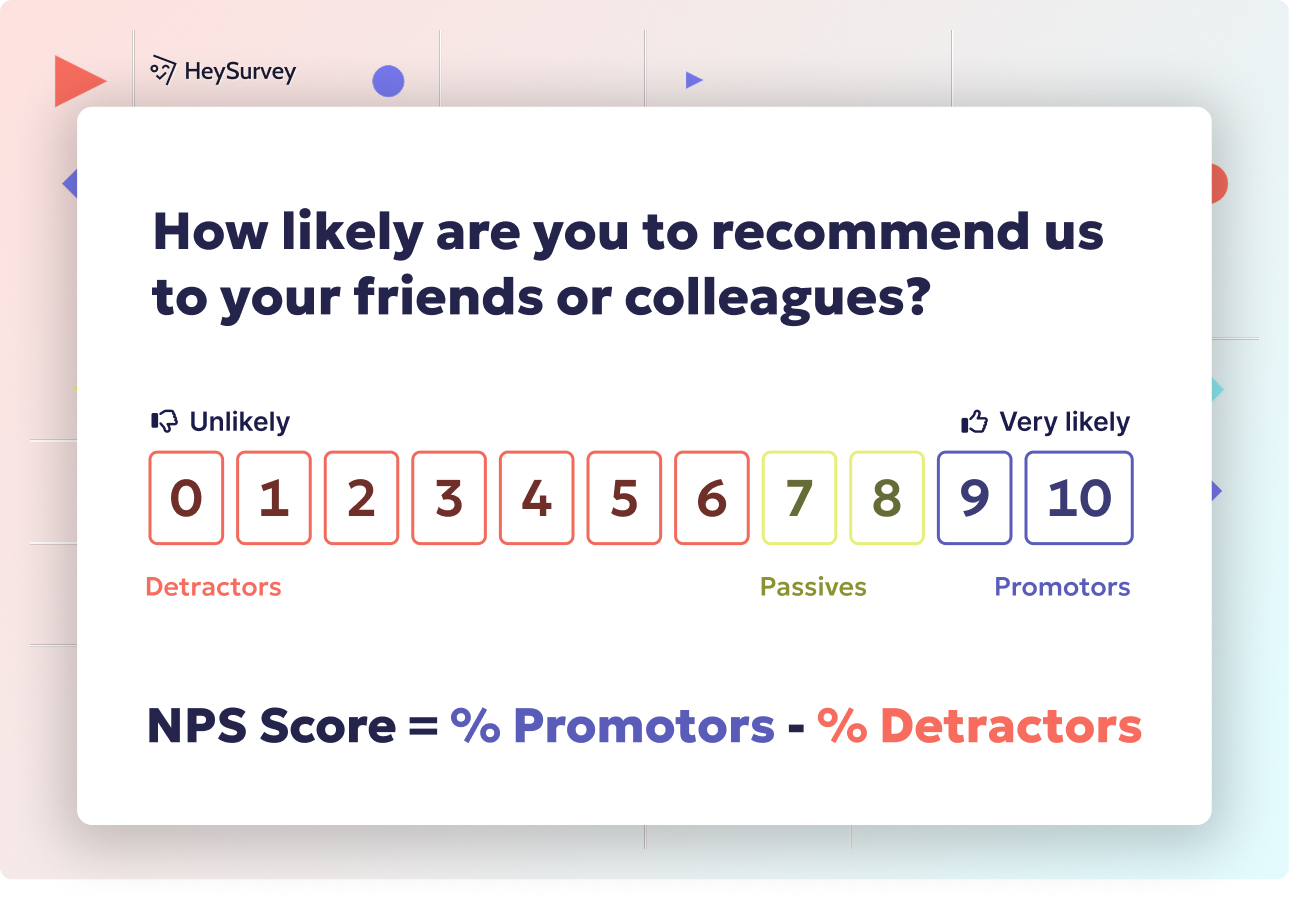
How to Create a Ratio Survey with HeySurvey: 3 Easy Steps (Plus a Bonus!)
If you’re new to HeySurvey, fear not! Creating a professional survey with ratio survey questions can be a breeze. Just follow these simple steps, and you’ll be ready to gather meaningful numeric data in no time. Ready to jump in? There’s even a handy button below to open a pre-designed template and start now!
Step 1: Create a New Survey
- Open HeySurvey and choose how you want to start your survey—either from a blank sheet or select a pre-built template designed for ratio scale examples.
- Name your survey clearly so you can find it later, for example, “Customer Spend Survey - Q2” or “Fitness Tracking Questionnaire.”
- If you want to skip the blank slate, just hit the button below to open a ready-made template tailored to collecting ratio data.
Once the survey is created, the Survey Editor will appear—this is your playground to add and arrange questions.
Step 2: Add Ratio Survey Questions
- Click the Add Question button at the top or where you want to insert a question.
- Select the Number input question type to allow respondents to enter numeric values—with a true zero, of course.
- Write your question clearly with the measurement unit and timeframe, such as “How many hours did you work on Project A last week?” or “How many dollars did you spend on our product last month?”
- Mark the question as required if you want to make sure nobody skips these crucial data points.
- Repeat this for all your ratio questions—HeySurvey lets you duplicate questions to save time if needed.
Pro tip: always specify units (dollars, kilometers, hours) and timeframes clearly for best data quality.
Step 3: Publish Your Survey
- Once your questions are set, hit the Preview button to test what respondents will see. This helps catch errors or formatting issues.
- When everything looks good, click Publish to make your survey live. Remember, you’ll need to create a free account or log in to publish and collect responses.
- You’ll get a sharable link to send out via email, social media, or embed on your site.
Bonus Step 4: Customize Your Survey Branding and Settings
- In the Designer Sidebar, upload your logo and customize colors, fonts, and backgrounds for a branded feel.
- Head over to the Settings Panel to set start and end dates, limit the number of responses, or create a redirect URL after completion.
- Define whether you allow respondents to view results (great for engagement) or keep results private.
Bonus Step 5: Use Branching to Personalize the Survey Flow
- Want to guide respondents based on answers? Use HeySurvey’s branching feature to skip irrelevant questions or show more detailed follow-ups.
- For example, if someone reports zero usage in a usage frequency survey, you can skip questions about frequent buyers, making the experience smoother and data cleaner.
Creating your first ratio survey? Click the button below to open a ready-to-go template and get started instantly!
Customer Spending & Budget Allocation Surveys
Why Use This Survey Type?
Curious about how much your customers are really shelling out on your product or service? Customer spend survey methods deliver quantifiable answers that beat broad ballpark guesses. By capturing exact amounts or budget shares, you can detect actual ROI, optimize pricing, or forecast future revenues with confidence.
You’ll want to turn to budget allocation question examples when you:
- Need to justify a budget increase internally with real customer data.
- Hope to identify your share of wallet compared to competitors.
- Want to segment audiences based on actual spend, not just intentions.
When to Use It?
Deploy these surveys post-purchase, after annual budgeting cycles, or any time you’re analyzing pricing experiments. Startups use these in competitive mapping, while marketing teams love them when reporting campaign ROI.
5 Sample Ratio Survey Questions for Customer Spend
How many dollars did you spend on our product in the past month?
What percentage of your total streaming budget went to our services last year?
How much did you invest in software subscriptions in the previous quarter?
What amount (in your local currency) did you allocate for travel expenses last year?
How much do you expect to spend on maintenance for our product this year?
By focusing on ratio survey questions in this context, you empower your organization to make sharper fiscal decisions and deliver well-tailored offers. These numbers don’t just fill spreadsheets; they paint a precise picture of your customer’s wallet.
Research indicates that over 90% of individuals who budget do so by tracking their spending within distinct categories of consumption. (sciencedirect.com)
Time-Use & Workplace Productivity Surveys
Why Focus on Time?
In today’s fast-moving world, every minute counts—literally. If you’re looking to weed out inefficiencies, set fair KPIs, or simply understand how teams tick, time tracking survey questions deliver the goods. Knowing the exact minutes and hours your team spends on projects helps calculate labor costs with laser precision.
Using productivity ratio scale questions, you can:
- Identify process bottlenecks (where’s all the time going?).
- Justify hiring or automation by quantifying work.
- Benchmark against best practices and see measurable gains.
When to Use It?
These surveys are best deployed during time & motion studies, process optimizations, and especially when adopting remote or hybrid work models. Team leads and HR departments love them for performance reviews.
5 Sample Time-Use Ratio Survey Questions
How many hours did you dedicate to project A this week?
How much time (in minutes) did you spend on administrative tasks yesterday?
What is the average number of hours you work remotely per week?
How long (in hours) did it take to resolve your last customer ticket?
How much of your daily work time is spent in meetings?
Harnessing time tracking survey questions enables analytics that reveal exactly where interventions are needed. Numbers like these can mean the difference between overtime and optimal work-life balance—or between missed deadlines and newfound efficiency.
Consumption & Usage Frequency Surveys
Why Measure Consumption?
Tracking how often customers use your product or service is the secret ingredient for understanding demand, modeling churn, and powering your retention or growth strategies. If you want to design usage-based pricing or simply check how sticky your product is, you need precise answers—not just “yes” or “sometimes.”
Through usage frequency survey tools, marketers, product managers, and customer success teams can:
- Identify heavy users and target them with loyalty perks.
- Spot at-risk customers before they churn.
- Tailor communications and upsell offers based on real behavior.
When to Use It?
These questions shine during new product launches, feature adoption analyses, and in-app surveys that guide product-led growth. Retention managers also deploy them to uncover disengagement early.
5 Sample Consumption Ratio Survey Questions
How many cups of coffee do you brew with our machine per day?
What is the total number of times you logged into our app last month?
How many units of our consumable product did you purchase in the past quarter?
How many rides did you book through our platform last week?
How many gallons of our fuel did you use in the past month?
Gathering data with consumption measurement questions means you’re never left guessing about your audience’s habits. It’s all about knowing what’s hot, who’s hyped, and where improvement may be needed—one number at a time.
Including a clearly defined time period in behavioral frequency survey questions enhances the accuracy and reliability of respondents' answers. (qualtrics.com)
Pricing Sensitivity & Willingness-to-Pay Surveys
Why Measure Price Sensitivity?
If you picture your customers’ wallets as treasure chests, only willingness to pay survey questions hold the key. Exact budgets, price ceilings, and floors come to light, helping you set optimal prices, forecast sales, and predict drop-offs after a price change. Only with true numbers can you make informed, confident moves.
Ratio price survey methods allow you to:
- Identify pricing sweet spots, boosting profit and engagement.
- Detect market trends and react faster than competitors.
- Reduce risk when testing new price points or market segments.
When to Use It?
Best invoked ahead of new product or feature launches, during price-increase risk assessments, or when benchmarking against direct rivals. Product managers and growth strategists depend on these numbers for mission-critical decisions.
5 Sample Ratio Survey Questions for Price Sensitivity
What is the maximum amount in USD you would pay for a monthly subscription to our service?
What is the lowest price (in your currency) at which you would still consider our product high quality?
How much did you spend on similar products in the past year?
What would you expect to pay for expedited delivery in dollars?
How much, at minimum, would you be willing to pay for our premium tier each month?
Sprinkling willingness to pay survey questions throughout your feedback loop ensures you’re never caught off guard by what your market thinks is a fair deal. Confidence in pricing comes from the security of real, ratio-scale numbers.
Health & Fitness Tracking Surveys
Why Track Health Metrics?
Wellness isn’t just warm fuzzies and yoga mats—it’s about quantifiable gains. Every kilometer run, calorie burned, or pound lost offers insight for health professionals, coaches, and app developers. The real power lies in health metric survey questions that gather these measurable units.
Using a fitness tracking questionnaire, you can:
- Provide users with personal progress dashboards.
- Give clinicians reliable data for longitudinal studies.
- Cut through the fluff and see real movement toward fitness goals.
When to Use It?
Perfect for onboarding in fitness apps, continuous wellness programs, or long-term health studies. Gyms, sports clubs, and remote care providers also tap into these questions for tailored support and reporting.
5 Sample Ratio Survey Questions for Health & Fitness
How many kilometers did you run last week?
What is your current weight in kilograms?
How many calories did you consume yesterday?
How many days per week do you exercise for at least 30 minutes?
How much water (in liters) did you drink on your most active day this month?
By turning to health metric survey strategies, you give individuals and organizations trusted numbers—fueling motivation, accountability, and smarter solutions every step of the way.
Best Practices (Dos and Don’ts) for Crafting Ratio Survey Questions
Dos: Ratio Survey Question Success Tips
Designing ratio survey questions can feel a bit like tuning a finely-strung violin—small mistakes result in clunky data, but tuning them just right yields powerful insights. Here’s how to hit the right notes:
- Always state clear, concrete units (e.g., dollars, hours, cups, kilometers).
- Specify time frames to ensure apples-to-apples comparisons.
- Allow for a true zero value—respondents need to be able to say “none.”
- Pilot-test your ranges to check for common expectations and odd outliers.
Consider best practices supported by authorities like the APA and SurveyMonkey:
- Use logical survey logic branching to avoid irrelevant questions.
- Validate inputs and clarify min/max ranges to catch typos or errors.
- Apply data cleaning tips to neatly sweep away noise before analysis.
Don’ts: Pitfalls to Dodge
Just as important as the “Dos,” here’s what you should skip to keep your numeric survey questions with true zero in tip-top shape:
- Don’t mix units in a single question (e.g., "hours and days" in the same field).
- Never force a response where it doesn’t apply—use “Not applicable” or allow skips.
- Don’t forget to check validation rules (e.g., negative distances can lead to giggles).
- Avoid rounding or grouping too soon; let your dashboard handle the summaries.
If in doubt, return to the basics: every ratio question should let users respond with their own, true numbers. By keeping these tips front and center, you’ll breathe confidence into your quantitative questionnaire design.
Conclusion: Maximizing Insight & Action with Ratio Questions
Ratio survey questions unlock a new dimension of insight for any research or business goal. From health tracking to customer spend, their precision and analytical muscle help you see the big picture in bright, bold numbers. Explore A/B testing numeric ranges or integrating these gold nuggets with your analytics dashboards. For next-level results, try our free ratio-question template—or sign up for a survey software trial. Smart questions create smarter strategies!
Related Question Design Surveys

29 Quantitative Survey Research Questions Example for Success
Explore 25+ quantitative survey research questions example with clear explanations and tips for c...
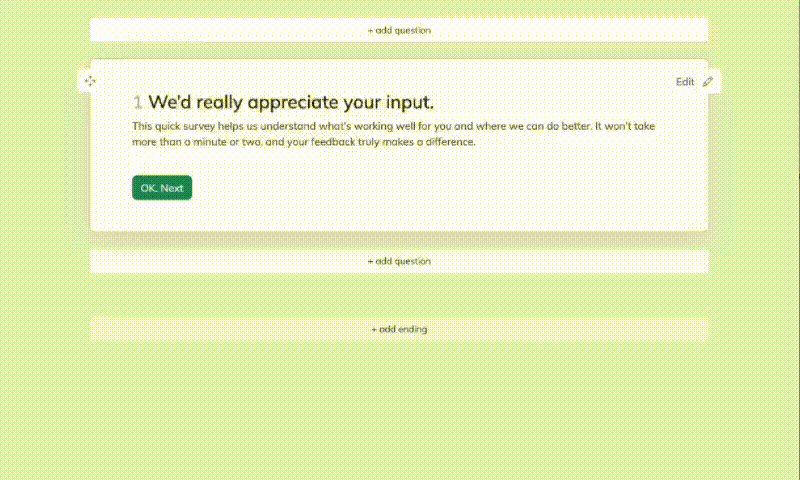
32 Good Survey Question to Boost Your Data Quality
Discover how to craft good survey questions with 30 sample questions across 8 types for better da...
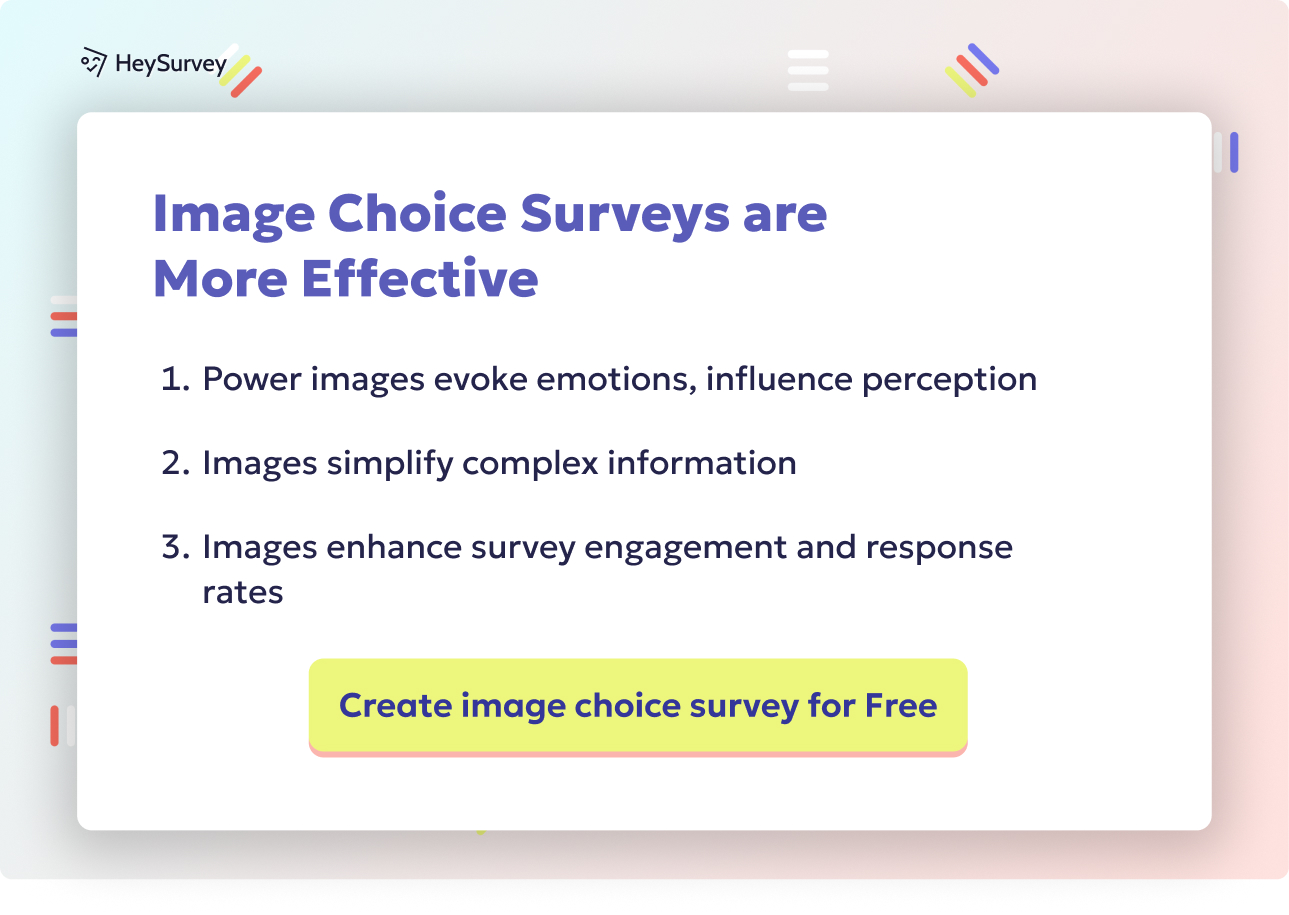
31 Survey Question Mistakes You Need to Avoid Today
Discover 25 common survey questions mistakes with real examples and expert tips to craft clear, u...
